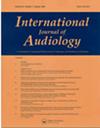视觉强化测听的优化:范围综述。
IF 1.8
3区 医学
Q2 AUDIOLOGY & SPEECH-LANGUAGE PATHOLOGY
引用次数: 0
摘要
目的视觉强化测听(VRA)是一种成熟的行为测试,用于评估婴幼儿的听力。本范围综述旨在总结临床实践中优化和提高 VRA 有效性的不同方法的证据。间歇性条件反射(只有 50% 的条件反射试验获得奖励)对反应行为没有影响,条件反射期间使用的(超阈值)呈现水平也没有影响。年龄较小(12 个月左右)的婴儿比年龄较大(18-24 个月左右)的婴儿做出的反应更多。结论 对于大多数发育年龄在 7-24 个月左右的婴儿来说,VRA 是一种成功的行为听力测试,其临床实施方案已得到完善的描述。需要进一步的证据来评估不同强化物、不同听觉刺激(如过滤熟悉的声音)和辅助反应检测技术的潜在益处。本文章由计算机程序翻译,如有差异,请以英文原文为准。
Optimisation of visual reinforcement audiometry: a scoping review.
OBJECTIVE
Visual reinforcement audiometry (VRA) is a well-established behavioural test used to assess hearing in infants and young children. This scoping review aimed to summarise the evidence for different approaches to optimising and improving the effectiveness of VRA for clinical practice.
DESIGN
A pre-registered scoping review was conducted.
STUDY SAMPLE
Fifty-nine original articles were included in the review.
RESULTS
The review identified a number of factors which improved response behaviour, such as increased variety and complexity of visual reinforcers, short reinforcer durations, and providing breaks. Intermittent conditioning, where as few as 50% of conditioning trials were rewarded, did not have an impact on response behaviour, and neither did the (suprathreshold) presentation level used during conditioning. More responses were achieved for younger (around 12 months) than older (around 18-24 months) infants. Once infants were developmentally ready to condition to play audiometry, this allowed for a more comprehensive hearing evaluation.
CONCLUSIONS
VRA is a successful behavioural hearing test for most infants of developmental age around 7-24 months, with well-established protocols describing its clinical implementation. Further evidence is needed to assess potential benefits of different reinforcers, different auditory stimuli (e.g. filtered familiar sounds), and technologies to assist response detection.
求助全文
通过发布文献求助,成功后即可免费获取论文全文。
去求助
来源期刊

International Journal of Audiology
医学-耳鼻喉科学
CiteScore
4.90
自引率
14.80%
发文量
133
审稿时长
4-8 weeks
期刊介绍:
International Journal of Audiology is committed to furthering development of a scientifically robust evidence base for audiology. The journal is published by the British Society of Audiology, the International Society of Audiology and the Nordic Audiological Society.
 求助内容:
求助内容: 应助结果提醒方式:
应助结果提醒方式:


